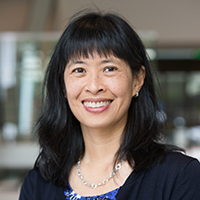
Health misinformation is prolific online, particularly on social media platforms like TikTok, YouTube and Instagram. Search for any health term and you’re bound to find videos, articles and blogs promoting fake cures, detoxes and all-natural remedies. While some of these claims are harmless, in the case of serious diseases like cancer, the consequences can be deadly. Take former Apple co-founder Steve Jobs, who fell prey to misinformation and decided to eschew traditional cancer treatment, which led to his untimely death in 2011.
“It’s alarming just how much misinformation is out there,” said June Chan, ScD, professor of epidemiology and biostatistics at UCSF. Chan is the senior author of a recent paper published in CA: A Cancer Journal for Clinicians about the proliferation of cancer misinformation on social media. The article describes the types of cancer misinformation that are prevalent on social media, as well as what physicians can do to combat cancer misinformation.
Many Social Media Posts Contain False or Misleading Health Information
Social media communities are widely used, both by cancer professionals and advocates, as well as patients and families hoping to make sense of a diagnosis. “Unfortunately, the proportion of false information compared to correct information is very high,” said Chan.

For example, one study found that among the top 55 posts about prostate cancer on TikTok, only 31 percent contained objective information while 41 percent contained misinformation. Another study found that among the first 150 videos about prostate cancer on YouTube, 77 percent contained poor-quality information, biased information or misinformation. Collectively, these videos had over six million views.
Health misinformation can also be extremely deceptive — one study found that 41 percent of oncology health professionals and advocates who responded to a survey had difficulty determining which information was credible on social media.
“The majority of people get their health information online,” said Stacy Loeb, MD, professor of urology and population health at NYU Langone Health and first author on the paper. “So, it’s important to understand the quality of information people see about different health topics when they visit different online networks.”
Strategies for Fighting Back Against Misinformation
Luckily, Chan and Loeb said, there are strategies to combat cancer misinformation online. Right now, however, the burden of battling misinformation falls mostly on patients and their family members. Chan and Loeb both said that while patients should continue looking out for misinformation, physicians and social media companies should bear some responsibility, too.
For patients, family and community members worried about health misinformation, Chan and Loeb cite a U.S. Surgeon General Health Misinformation Community Toolkit that involves a checklist that can help people identify common forms of health misinformation. The checklist consists of asking yourself, “Did you ask a credible healthcare professional such as your doctor or nurse if they have additional information?” and “Did you look at the ‘About Us’ page on the website to see if you can trust the source?”
An intervention that Chan and Loeb recommend for physicians is to give patients an “information prescription” — tools that can help patients differentiate between legitimate and illegitimate information and resources to find helpful information. That’s why many UCSF websites offer comprehensive patient education resources, Chan says, to preemptively combat online misinformation.
Additionally, it can be helpful for physicians and advocates to have a presence on social media to combat misinformation in real time. “It’s very important to participate in online platforms and share evidence-based information so there are high-quality resources out there,” Loeb said.
However, the authors said physicians, patients and family members don’t have the bandwidth to stop the millions of misinformation posts that appear online. Social media companies also need to take responsibility and create stronger regulations and enforcement surrounding medical misinformation online. While some social media sites flag health misinformation, Chan and Loeb said in their paper that they could do more. To really combat harmful health misinformation, social media platforms should take responsibility for monitoring misinformation, identifying misinformation “super-spreaders,” and amplifying communications from trusted sources.
“Combating misinformation on social media will make finding quality information online easier for patients with cancer” said Chan, “and for patients, information is power.”
Loeb and Chan have already started their next research project delving into cancer misinformation. They are working on an R01 grant supported by the National Cancer Institute to study misinformation about prostate cancer on social media, as well as possible mitigation strategies.
